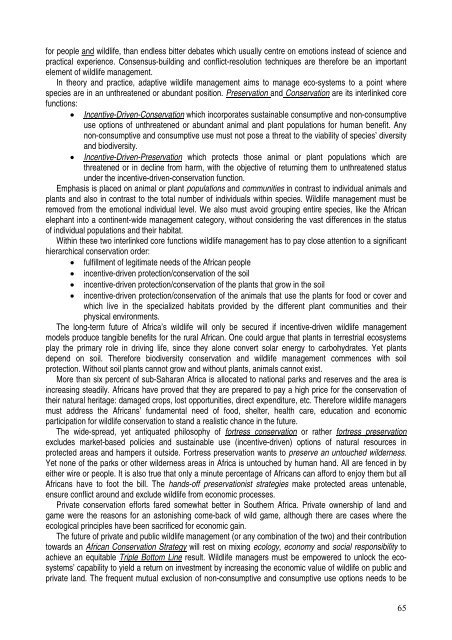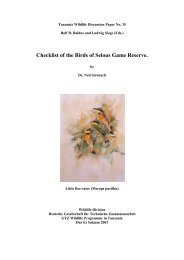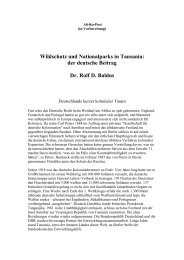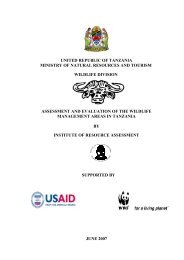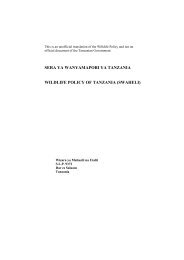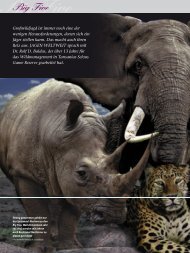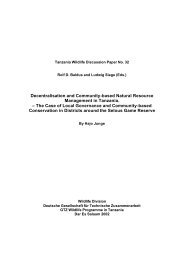African Indaba Articles - wildlife-baldus.com
African Indaba Articles - wildlife-baldus.com
African Indaba Articles - wildlife-baldus.com
You also want an ePaper? Increase the reach of your titles
YUMPU automatically turns print PDFs into web optimized ePapers that Google loves.
for people and <strong>wildlife</strong>, than endless bitter debates which usually centre on emotions instead of science andpractical experience. Consensus-building and conflict-resolution techniques are therefore be an importantelement of <strong>wildlife</strong> management.In theory and practice, adaptive <strong>wildlife</strong> management aims to manage eco-systems to a point wherespecies are in an unthreatened or abundant position. Preservation and Conservation are its interlinked corefunctions:• Incentive-Driven-Conservation which incorporates sustainable consumptive and non-consumptiveuse options of unthreatened or abundant animal and plant populations for human benefit. Anynon-consumptive and consumptive use must not pose a threat to the viability of species’ diversityand biodiversity.• Incentive-Driven-Preservation which protects those animal or plant populations which arethreatened or in decline from harm, with the objective of returning them to unthreatened statusunder the incentive-driven-conservation function.Emphasis is placed on animal or plant populations and <strong>com</strong>munities in contrast to individual animals andplants and also in contrast to the total number of individuals within species. Wildlife management must beremoved from the emotional individual level. We also must avoid grouping entire species, like the <strong>African</strong>elephant into a continent-wide management category, without considering the vast differences in the statusof individual populations and their habitat.Within these two interlinked core functions <strong>wildlife</strong> management has to pay close attention to a significanthierarchical conservation order:• fulfillment of legitimate needs of the <strong>African</strong> people• incentive-driven protection/conservation of the soil• incentive-driven protection/conservation of the plants that grow in the soil• incentive-driven protection/conservation of the animals that use the plants for food or cover andwhich live in the specialized habitats provided by the different plant <strong>com</strong>munities and theirphysical environments.The long-term future of Africa’s <strong>wildlife</strong> will only be secured if incentive-driven <strong>wildlife</strong> managementmodels produce tangible benefits for the rural <strong>African</strong>. One could argue that plants in terrestrial ecosystemsplay the primary role in driving life, since they alone convert solar energy to carbohydrates. Yet plantsdepend on soil. Therefore biodiversity conservation and <strong>wildlife</strong> management <strong>com</strong>mences with soilprotection. Without soil plants cannot grow and without plants, animals cannot exist.More than six percent of sub-Saharan Africa is allocated to national parks and reserves and the area isincreasing steadily. <strong>African</strong>s have proved that they are prepared to pay a high price for the conservation oftheir natural heritage: damaged crops, lost opportunities, direct expenditure, etc. Therefore <strong>wildlife</strong> managersmust address the <strong>African</strong>s’ fundamental need of food, shelter, health care, education and economicparticipation for <strong>wildlife</strong> conservation to stand a realistic chance in the future.The wide-spread, yet antiquated philosophy of fortress conservation or rather fortress preservationexcludes market-based policies and sustainable use (incentive-driven) options of natural resources inprotected areas and hampers it outside. Fortress preservation wants to preserve an untouched wilderness.Yet none of the parks or other wilderness areas in Africa is untouched by human hand. All are fenced in byeither wire or people. It is also true that only a minute percentage of <strong>African</strong>s can afford to enjoy them but all<strong>African</strong>s have to foot the bill. The hands-off preservationist strategies make protected areas untenable,ensure conflict around and exclude <strong>wildlife</strong> from economic processes.Private conservation efforts fared somewhat better in Southern Africa. Private ownership of land andgame were the reasons for an astonishing <strong>com</strong>e-back of wild game, although there are cases where theecological principles have been sacrificed for economic gain.The future of private and public <strong>wildlife</strong> management (or any <strong>com</strong>bination of the two) and their contributiontowards an <strong>African</strong> Conservation Strategy will rest on mixing ecology, economy and social responsibility toachieve an equitable Triple Bottom Line result. Wildlife managers must be empowered to unlock the ecosystems’capability to yield a return on investment by increasing the economic value of <strong>wildlife</strong> on public andprivate land. The frequent mutual exclusion of non-consumptive and consumptive use options needs to be65


